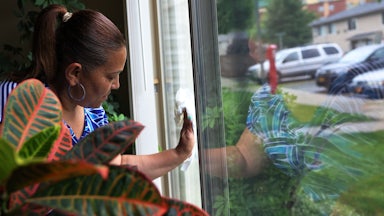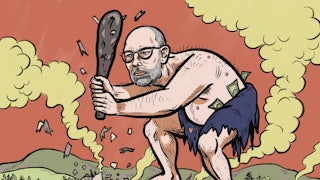People are quitting their jobs, and there’s an uptick in labor unrest. A labor market shortage that I predicted would be gone by early September (or even early July!) persists. That’s because the Covid pandemic persists. You want to understand the direction of the economy, don’t ask an economist. Ask an epidemiologist. Or you might try a psychologist. More on that in a bit.
It’s still a bad time to own a restaurant, because people still don’t want to dine indoors. Revenues are creeping up, but they’re still nowhere near their pre-pandemic level. The National Restaurant Association’s various performance indices were down in August, the most recent month for which we have statistics, even as vaccination levels climbed. The death of double-vaxxed Colin Powell won’t encourage people to venture out to their favorite restaurant anytime soon.
It’s also still a bad time to own an airline. In North America, airlines aren’t projected to return to profitability until next year, and the airline industry is recovering much more quickly in the United States than anywhere else. Government restrictions obviously play a role, and those are starting to go away. But even places that make it comparatively easy to visit from the U.S., like the United Kingdom, are still suffering. I flew to London and back this month on planes that were two-thirds empty. The flight attendants encouraged passengers to take whole rows for themselves so that they could sleep more easily on the long flight and achieve greater social distance from others.
There’s no reason to assume employees are any less fearful than consumers of exposing themselves to the delta variant. According to a Morning Consult tracking poll, the percentage of remote workers who reported feeling comfortable with returning to their workplaces rose starting in February, peaked in July at 73 percent, fell thereafter to 51 percent in early September, and is now creeping back up again. But as of October 9, the most recent date for which data were available, 40 percent of remote workers still were uncomfortable with returning to work. Throughout the pandemic, about half of remote workers said they’d consider quitting if the boss tried to wrangle them back to the office before they felt safe. In response to such sentiments, a Gartner poll in late August found that 66 percent of employers delayed reopening their offices.
People who work remotely tend to have some influence over their bosses about when to return to work. Frontline workers in hotels and restaurants don’t. As a consequence, these workers, with a little help from pissed-off warehouse workers and teachers, drove the Bureau of Labor Statistics’ “quits rate” to 2.9 percent in August. That’s higher than it’s ever been (JOLTS data, tracking job openings and labor turnover, goes back to December 2000).
The previous high was in April 2020, when everybody was quitting their job because a deadly pandemic had just begun, which of course made perfect sense. It makes less obvious sense now that the threat is lower, but consider the Covid seesaw since the start of this year. In a rough mirror image of the Morning Consult poll, new Covid cases dropped through February, then climbed to their highest point since the pandemic began in early May, then dropped by late June to their low February level, then shot up again through August. Just looking at the chart makes me want to say, “Screw this.” (Since August, new cases have been dropping. Let’s hope they continue to drop.)
The quits rate typically measures workers’ confidence. It’s an index of how much crap workers are willing to put up with from the boss. In normal times, that reading is “an unbelievable amount of crap” (pardon my technical jargon), in large part because fully 93.7 percent of private-sector workers don’t belong to a union. In flush times, the reading is “only a medium amount of crap” or even “very little crap at all.” That’s because so many jobs are available that you can quit your job with reasonable confidence that you’ll find another one quickly. Maybe you have one already.
The riddle here is that we have a high quits rate, yet these are not especially good times. On the one hand, there are a lot of job openings: 10.4 million on the last business day of August, down from 11.1 million in July but still very high. (July’s 11.1 million was the most job openings since December 2000.) Come and get ’em! But not a lot of people want ’em, and you can’t say it’s because everybody’s got a job already. The unemployment rate in August was 5.2 percent, which is much higher than in February 2020, when the economy was still humming. The unemployment rate in February 2020 was a mere 3.5 percent. That should have left workers feeling much more emboldened to tell the boss, “Take this job and shove it.” But they weren’t; the quits rate in February 2020 was much lower (2.3 percent) than it was in August.
That suggests that in the current climate the quits rate is an index less of worker confidence than of worker burnout. Anthony Klotz, a professor at Texas A&M who studies why people quit their jobs, labels what’s happening the “Great Resignation.” Here’s how he described it to Bloomberg Businessweek (back in May, before it was actually happening): “When there’s uncertainty, people tend to stay put, so there are pent-up resignations that didn’t happen over the past year.” The phrase “the Great Resignation” immediately went crazily viral, and Klotz was sought out by The Wall Street Journal, The New York Times, the BBC, The Washington Post, and various other news outlets.
It’s telling that the most popular village explainer of the current labor shortage should be not an economist but a psychologist. Klotz teaches at Texas A&M’s Mays Business School, but he holds a doctorate not in economics but in organizational behavior. Economists say workers are demanding higher wages, or trading crap jobs for better-paying ones, or being choosy because they can live off saved-up extended unemployment benefits that expired in September. It’s certainly possible such speculations are true, and if they are, hallelujah. But any explanation rooted too deeply in the particulars of the U.S. economy bumps up against the fact that—as columnist Ishaan Tharoor observed Monday in The Washington Post—the Great Resignation is global. It’s happening pretty much everywhere. What do workers of the world have in common? (Besides, of course, the desire to lose their chains.) They are, all of them, sick and tired of the global pandemic.
The Great Resignation is less about what’s in a worker’s wallet than it is about what’s in a worker’s head. So I phoned this Aggie psychologist who came so highly recommended, and I stretched out on his virtual couch. I told him what’s troubling me. His answers were very persuasive.
Reports of burnout on the job, Klotz told me, “are about as widespread as they could be.” Frontline workers have experienced the worst of it, but you see it everywhere: “caregivers, executives, mid-level managers, shift workers.” Most likely, dear reader, you have experienced some version of this yourself. There’s also a memento mori aspect, or what Klotz calls “mortality cues.” Folks are dying from Covid-19, and there’s a decent chance you know one or more of them. “When people come into contact with death or illness,” explained Klotz, “it causes us to take a step back and think existential thoughts.” The lockdown has given many of us time to think these matters over.
Finally, we’ve learned during the pandemic that an awful lot of people really like working at home. An October 13 Gallup poll found fully 91 percent want to do at least some of their work from home after the pandemic. “It definitely gives us more freedom to arrange our days,” Klotz said. “When we are given autonomy, we tend not to give it up willingly.”
How permanent these psychological effects will be, Klotz said, is anybody’s guess. But among older workers, the Great Resignation looks more like the Great Early Retirement. A July New York Times story reported that about twice as many people retired during the pandemic as in 2019 and that the rate of retirements has been faster than it was during the Great Recession of 2007–2009. A lot of these retirements—and the majority among people at or below median income—are involuntary. But Klotz told me he’s spoken to plenty of older workers looking for ways to cut back hours or quit work altogether. Older workers are more susceptible to mortality cues, and they have more to fear from contracting Covid-19. They don’t share the younger generation’s delusion of eternal life. They may also be a bit likelier, after a lifetime in the labor force, to feel fed up with their work lives.
It’s too early to conclude that Covid-19 is changing the labor force in any lasting way. We’ll know more about that when the pandemic ends. That’s assuming it ever does. If it doesn’t, today’s session with Klotz won’t be my last 50-minute hour.






